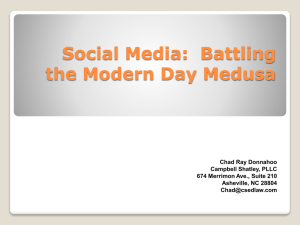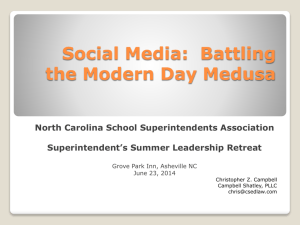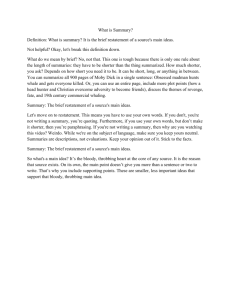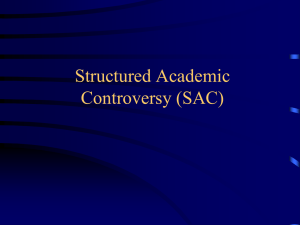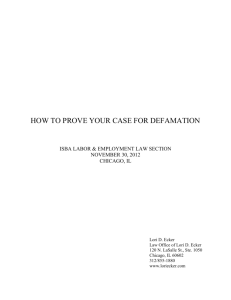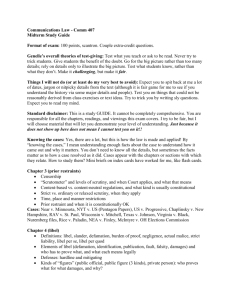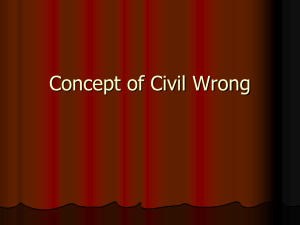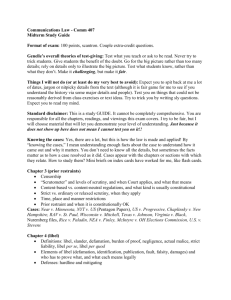presentation source
advertisement
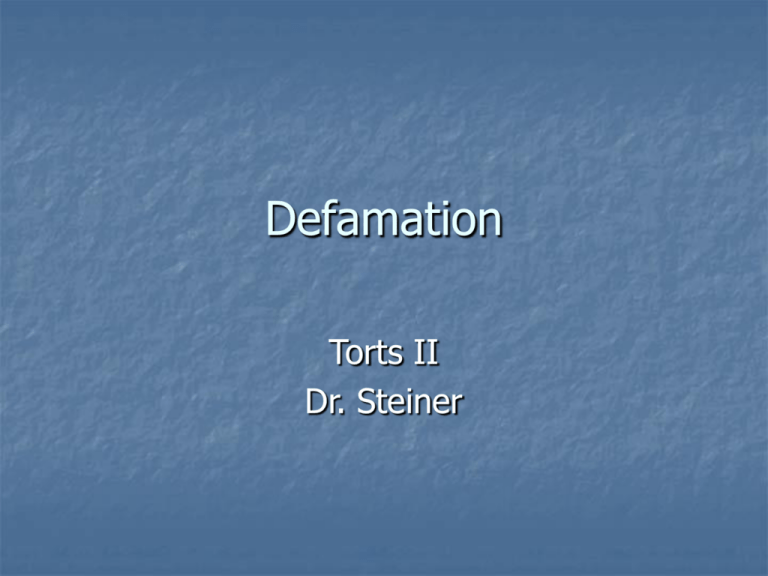
Defamation Torts II Dr. Steiner Good name in man and woman, dear my lord, Is the immediate jewel of their souls: Who steals my purse steals trash; 'tis something, nothing; 'Twas mine, 'tis his, and has been slave to thousands; But he that filches from me my good name Robs me of that which not enriches him And makes me poor indeed. William Shakespeare, Othello Defamation Injury to Reputation Slander Libel General requirements Defendant publishes to third party Defamatory statements Of and concerning plaintiff Restatement 2d Torts § 559. Defamatory Communication Defined A communication is defamatory if it tends so to harm the reputation of another as to lower him in the estimation of the community or to deter third persons from associating or dealing with him. Restatement 2d Torts § 559, cmt b. Communications are often defamatory because they tend to expose another to hatred, ridicule or contempt. A defamatory communication may tend to disparage another by reflecting unfavorably upon his personal morality or integrity or it may consist of imputations which, while not affecting another's personal reputation, tend to discredit his financial standing in the community, and this is so whether or not the other is engaged in business or industry. Restatement 2d Torts § 559, cmt c. A communication may be defamatory of another although it has no tendency to affect adversely the other's personal or financial reputation. Thus the imputation of certain physical and mental attributes such as disease or insanity are defamatory because they tend to deter third persons from associating with the person so characterized. Belli v. Orlando Daily Newspapers False statement? Libel per quod Libel per se Court’s role and jury’s role De mortuis nil nisi bonum Do not speak ill of the dead. But if you do, don’t worry about a defamation suit. Problem 1 Red Paper Issues Election Extra The San Francisco People's World, recognized throughout the state as the mouthpiece of the communist party, distributed a last-minute extra edition in Oakland yesterday, on the eve of the city election. . . . The Communist-line paper . . . printed a list of recommendations which included the names of council candidates John F. Quinn, John W. Holmdahl, and Dr. Grover H. MacLeod. Problem 2 Problem 3 Rice v. Simmons, 2 Del. (2 Harr.) 417, 429 (1838) That mere general abuse and scurrility, however ill-natured and vexatious, is no more actionable when written than spoken, if it do not convey a degrading charge or imputation. Against all such attacks, a man needs no other protection than a good character; and the law will not suppose that damage can happen to such a character from the pointless arrows of mere vulgarity. Problem 4 Problem 5 Problem 6 Neiman-Marcus v. Lait Neiman-Marcus v. Lait Neiman-Marcus v. Lait Group libel Precedent Four coroners, twelve doctors, a posse, and twelve radio editors All officials of a state-wide union, all D.C. taxicab drivers, all D.C. parking lot owners, members of a clan Neiman Marcus Models? Male sales clerks? Female sales clerks? Restatement 1st Torts § 564, illus. 2 A newspaper publishes the statement that some member of B's household has committed murder. In the absence of any circumstances indicating that some particular member of B's household was referred to, the newspaper has defamed each member of B's household. Problem 1 Salomone v. Macmillan Pub. Co., Inc., 411 N.Y.S.2d 105 (N.Y.Sup. 1978) Humor, then, may well be a defense to a suit in libel, but the mere assertion that a statement was meant to be funny does not automatically absolve the utterer. . . . What is amusing or funny in the eyes of one person may be cruel and tasteless to someone else. There is always a thin line between laughter and tears. . . . Especially is this true in dealing with parody and satire. Salomone v. Macmillan Pub. Co., Inc., 411 N.Y.S.2d 105 (N.Y.Sup. 1978) Parody, on the other hand, shuns subtlety. Its aim is to amuse and expose by imitating life, but larger than life. Its essence is distortion and exaggeration. Hence, like the warped and curved mirrors in a carnival fun house, it depends upon the grotesque for its effects. Salomone v. Macmillan Pub. Co., Inc., 411 N.Y.S.2d 105 (N.Y.Sup. 1978) Thus, the writer resorting to parody must be wary, for his shafts may miss the mark, and be cruel without purpose, inflicting real hurt where only laughter was intended. “However desirable it may be that the readers of and the writers for the public prints shall be amused, it is manifest that neither such readers nor writers should be furnished such amusement at the expense of the reputation or business of another.” Restatement 2d Torts § 564, cmt d Fictitious character. A libel may be published of an actual person by a story or essay, novel, play or moving picture that is intended to deal only with fictitious characters if the characters or plot bear such a resemblance to actual persons or events as to make it reasonable for its readers or audience to understand that a particular character is intended to portray that person. Mere similarity of name alone is not enough; nor is it enough that the readers of a novel or the audience of a play or a moving picture recognize one of the characters as resembling an actual person, unless they also reasonably believe that the character is intended to portray that person. Restatement 2d Torts § 564 If the work is reasonably understood as portraying an actual person, it is not decisive that the author or playwright did not so intend…. The fact that the author or producer states that his work is exclusively one of fiction and in no sense applicable to living persons is not decisive if readers actually and reasonably understand otherwise. Such a statement, however, is a factor to be considered by the jury in determining whether readers did so understand it, or, if so, whether the understanding was reasonable. Problem 2 Cohn v. Brecher, 192 N.Y.S.2d 877 (N.Y.Sup. 1959) The action of slander is necessarily based upon the words uttered and their defamatory nature as applied to plaintiff. From a reading or hearing of the words noted here, one cannot conclude that they were directed to the plaintiff alone or to him as one of a group of persons. . . . “An action for defamation lies only in case the defendant has published the matter ‘of and concerning the plaintiff.’” Cohn v. Brecher, 192 N.Y.S.2d 877 (N.Y.Sup. 1959) Here the words refer to one not specified of a group of persons. Whereas it is essential that the 'defamatory words must refer to some ascertained or ascertainable person, and that person must be the plaintiff. . . . “So, if the words reflect impartially on either A. or B., or on some one of a certain number or class, and there is nothing to show which one was meant, no one can sue.” Problem 3 Restatement 2d Torts § 564A, cmt c Even when the statement made does not purport to include all of the small group or class but only some of them, as in the case of "Some of A's children are thieves," it is still possible for each member of the group to be defamed by the suspicion attached to him by the accusation. In general, there can be recovery only if a high degree of suspicion is indicated by the particular statement. Thus the assertion that one man out of a group of 25 has stolen an automobile may not sufficiently defame any member of the group, while the statement that all but one of a group of 25 are thieves may cast a reflection upon each of them. Blaser v. Krattiger, 195 P. 359 (Or. 1921) It appears in evidence without dispute that in making the accusation in the lounging room in the presence of the men there assembled the defendant spoke the Swiss language. The proper pleading in such a case is to set out the actual words employed, together with a translation into English, with the averment that it is the true interpretation of the foreign language used, and that it was so understood by those who heard it. Blaser v. Krattiger, 195 P. 359 (Or. 1921) The substance of the doctrine seems to be that the defendant gave offense, if at all, by the use of foreign language, and he must be charged accordingly. It is necessary also to aver and prove the English signification so as to refer the tort to that standard of speech by which alone causes are adjudicated in this country. Moreover, no slander is or can be committed unless those hearing the words used understand their meaning. It is the impression on the mind of the hearer which constitutes the essence of slander. Restatement 2d Torts § 577, cmt Communication in foreign language. A libel may be published in a foreign language provided it is understood by the person to whom it is communicated. Thus to accuse another of a crime in a foreign language is a publication if the accusation is addressed to or overheard by third persons familiar with the language used. So, too, the printing of a libelous article in a newspaper in a foreign language is sufficient since it is presumed that the paper is disseminated among readers familiar with the language. Restatement 2d Torts § 577, Illus. 2 2. A, a Lithuanian, engages in a violent quarrel with B on the streets in the foreign section of Chicago. In his native tongue, A accuses B of murder. No one but B understands him. A has not published a slander. 3. The same facts as in Illustration 2, except that A is overheard by several of his countrymen. A has published a slander. Problem 4 Watson v. Detroit Journal Co., 107 N.W. 81 (Mi. 1906) Trading stamp concerns are spoken of in the first article set out in the declaration of the plaintiff as 'the get-rich-quick industry.' This refers to trading stamp concerns generally, and not to any particular trading stamp concern. In another article the business is spoken of as 'the trading stamp fake.' This refers to the business generally, and not to any particular individual. Watson v. Detroit Journal Co., 107 N.W. 81 (Mi. 1906) In another article it is said: 'Mr. Hunt appreciates the damage done to business by the trading stamp bloodsuckers.' This refers in general terms to the men engaged in the business, and not to any particular person engaged therein. We then have in this case a class of persons in Detroit engaged in the conduct of trading stamp concerns. A publication is made which does not refer to all of the persons engaged in that business in Detroit, but does refer generally to the trading stamp concerns of that city. We think the case stated will not sustain an action of libel. “Veggie Libel” Tex. Civ. Prac. & Rem. Code § 96.002 (a) A person is liable as provided by Subsection (b) if: (1) the person disseminates in any manner information relating to a perishable food product to the public; (2) the person knows the information is false; and (3) the information states or implies that the perishable food product is not safe for consumption by the public. (b) A person who is liable under Subsection (a) is liable to the producer of the perishable food product for damages and any other appropriate relief arising from the person's dissemination of the information. Problem 5 Problem 6 Pring v. Penthouse Intern., Ltd. 695 F.2d 438 (10th Cir. 1982) The charged portions of the story described something physically impossible in an impossible setting. In these circumstances we must [conclude] that it is simply impossible to believe that a reader would not have understood that the charged portions were pure fantasy and nothing else. It is impossible to believe that anyone could understand that levitation could be accomplished by oral sex before a national television audience or anywhere else. The incidents charged were impossible. The setting was impossible. Pring v. Penthouse Intern., Ltd. 695 F.2d 438 (10th Cir. 1982) The story is a gross, unpleasant, crude, distorted attempt to ridicule the Miss America contest and contestants. It has no redeeming features whatever. There is no accounting for the vast divergence in views and ideas. However, the First Amendment was intended to cover them all. The First Amendment is not limited to ideas, statements, or positions which are accepted; which are not outrageous; which are decent and popular; which are constructive or have some redeeming element; or which do not deviate from community standards and norms; or which are within prevailing religious or moral standards. Lent v. Huntoon The confusing semantics of common-law pleading Defenses to defamation Truth Privilege Predicate for damages Compensatory Punitive Restatement 2d Torts § 577 What Constitutes Publication (1) Publication of defamatory matter is its communication intentionally or by a negligent act to one other than the person defamed. (2) One who intentionally and unreasonably fails to remove defamatory matter that he knows to be exhibited on land or chattels in his possession or under his control is subject to liability for its continued publication. Restatement 2d Torts § 577, cmt k There is an intent to publish defamatory matter when the actor does an act for the purpose of communicating it to a third person or with knowledge that it is substantially certain to be so communicated. Restatement 2d Torts § 577, cmt k It is not necessary, however, that the communication to a third person be intentional. If a reasonable person would recognize that an act creates an unreasonable risk that the defamatory matter will be communicated to a third person, the conduct becomes a negligent communication. A negligent communication amounts to a publication just as effectively as an intentional communication. Restatement 2d Torts § 577, Illus. 4 A and B engage in an altercation on the street where there are a number of pedestrians. During the course of the quarrel, A in a loud voice accuses B of larceny, the accusation being overheard by a number of passers-by. A has published a slander. Restatement 2d Torts § 577, Illus. 5 A, a cartoonist, while working at his desk in an office building represents B, a member of the editorial staff, in a ludicrous attitude. A leaves the cartoon on his desk, where it can easily be seen by numerous people who pass by the desk. A stenographer subsequently sees the cartoon. A has published a libel. Restatement 2d Torts § 577, cmt o The accidental communication of matter defamatory of another to a third person is not a publication if there was no negligence. Thus, an act that is not intended to communicate to a third person matter that is defamatory and which does not create an unreasonable risk of the communication is not a publication. Restatement 2d Torts § 577, Illus. 12 A writes a letter to B containing defamatory statements about C. He puts the letter in his desk and locks it up. A thief breaks open the desk and reads the letter. A has not published a libel. Problem 1 Restatement 2d Torts § 577, Illus. 6 A writes a defamatory letter to B and sends it to him through the mails in a sealed envelope. A knows that B is frequently absent and that in his absence his secretary opens and reads his mail. B is absent from his office and his secretary reads the letter. A has published a libel. Roberts v. English Mfg., 46 So. 752 (Ala. 1908) In the civil action for libel it is necessary to show that the libelous matter was published by being communicated to some third person. Consequently a sealed letter, sent through the mail to the person who claims to be libeled, is not such a publication as the law requires, unless there is evidence to show that the party who sent it knew that some other person was in the habit of opening letters, or that in the ordinary course of business the contents of the letter would come to the knowledge of some third person. Problem 2 Problem 2 Lewis v. Equitable Life Assur. Soc’y., 389 N.W.2d 876 (Minn.1986) General rule: communication of a defamatory statement to a third person by the person defamed is not actionable Exception: if the plaintiff was compelled to communicate the defamatory statement to a third person, and if it was foreseeable to the defendant that the defamed person would be so compelled Problem 3 For illicit amatory ventures, call 555-1234 Restatement 2d Torts § 577, cmt p One who knows that defamatory matter is exhibited upon land or chattels in his possession or under his control and intentionally and unreasonably fails to remove it, becomes subject to liability for the continued publication. The basis of the liability is his duty not to permit the use of his land or chattels for a purpose damaging to others outside of the land. Restatement 2d Torts § 577, cmt p So far as the cases thus far decided indicate, the duty arises only when the defendant knows that the defamatory matter is being exhibited on his land or chattels, and he is under no duty to police them or to make inquiry as to whether such a use is being made. He is required only to exercise reasonable care to abate the defamation, and he need not take steps that are unreasonable if the burden of the measures outweighs the harm to the plaintiff. Restatement 2d Torts § 577, Illus. 15 A writes on the wall of the men's washroom in B's tavern a statement that C is an unchaste woman. B fails to discover the writing for an hour. After he discovers it, he fails to remove it for another hour, although he has ample opportunity to do so. During the second hour the writing is read by several men. B is subject to liability for the continued publication of the libel during the second hour, although not for the original publication. Hellar v. Bianco, 244 P.2d 757 (Cal.App.1952) Persons who invite the public to their premises owe a duty to others not to knowingly permit their walls to be occupied with defamatory matter…. The theory is that by knowingly permitting such matter to remain after reasonable opportunity to remove the same the owner of the wall or his lessee is guilty of republication of the libel…. Republication occurs when the proprietor has knowledge of the defamatory matter and allows it to remain after a reasonable opportunity to remove it. Tacket v. General Motors Corp., 836 F.2d 1042 (7th Cir.1987) The Restatement suggests that a tavern owner would be liable if defamatory graffiti remained in a bathroom stall a single hour after their discovery…. The common law of washrooms is otherwise, given the steep discount that readers apply to such statements and the high cost of hourly repaintings of bathroom stalls…. The burden of constant vigilance greatly exceeds the benefits to be had. Problem 4 Tacket v. General Motors Corp., 836 F.2d 1042 (7th Cir.1987) A person is responsible for statements he makes or adopts, so the question is whether a reader may infer adoption from the presence of a statement. That inference may be unreasonable for a bathroom wall or the interior of a subway car in New York City but appropriate for the interior walls of a manufacturing plant, over which supervisory personnel exercise greater supervision and control. The costs of vigilance are small (most will be incurred anyway), and the benefits potentially large (because employees may attribute the statements to their employer more readily than patrons attribute graffiti to barkeeps). Problem 5 Restatement 2d Torts § 581 (1) Except as stated in subsection (2), one who only delivers or transmits defamatory matter published by a third person is subject to liability if, but only if, he knows or has reason to know of its defamatory character. (2) One who broadcasts defamatory matter by means of radio or television is subject to the same liability as an original publisher. Restatement 2d Torts § 581, cmt d Under the rule stated in this Section, a news dealer is not liable for defamatory statements appearing in the newspapers or magazines that he sells if he neither knows nor has reason to know of the defamatory article. The dealer is under no duty to examine the various publications that he offers for sale to ascertain whether they contain any defamatory items. Unless there are special circumstances that should warn the dealer that a particular publication is defamatory, he is under no duty to ascertain its innocent or defamatory character. Restatement 2d Torts § 581, cmt e Bookshops and circulating or lending libraries come within the rule stated in this Section. The vendor or lender is not liable, if there are no facts or circumstances known to him which would suggest to him, as a reasonable man, that a particular book contains matter which upon inspection, he would recognize as defamatory. Thus, when the books of a reputable author or the publications of a reputable publishing house are offered for sale, rent or free circulation, he is not required to examine them to discover whether they contain anything of a defamatory character. First and Fourteenth Amendments Congress shall make no law respecting an establishment of religion, or prohibiting the free exercise thereof; or abridging the freedom of speech, or of the press; or the right of the people peaceably to assemble, and to petition the Government for a redress of grievances. No State shall make or enforce any law which shall abridge the privileges or immunities of citizens of the United States; nor shall any State deprive any person of life, liberty, or property, without due process of law; nor deny to any person within its jurisdiction the equal protection of the laws. Who’s Sullivan? What was false in the ad? In Montgomery, Alabama, after students sang `My Country, ‘Tis of Thee’ on the State Capitol steps, their leaders were expelled from school, and truckloads of police armed with shotguns and tear-gas ringed the Alabama State College Campus. Again and again the Southern violators have answered Dr. King’s peaceful protests with intimidation and violence. They have bombed his home almost killing his wife and child. They have assaulted his person. They have arrested him seven times--for “speeding,” “loitering” and similar “offenses.” And now they have charged him with “perjury”--a felony under which they could imprison him for ten years. New York Times v. Sullivan Did the ad hurt Sullivan’s reputation? Was there any proof that his reputation was damaged? What is the New York Times and the four clergymen’s defense under Alabama law? What’s the issue before court? What’s the purpose of the First Amendment? Do public officials need “fortitude”? “Actual malice”: What is it? Whose burden to prove it? “Of and concerning” Sullivan? In Montgomery, Alabama, after students sang `My Country, ‘Tis of Thee’ on the State Capitol steps, their leaders were expelled from school, and truckloads of police armed with shotguns and teargas ringed the Alabama State College Campus. Again and again the Southern violators have answered Dr. King’s peaceful protests with intimidation and violence. They have bombed his home almost killing his wife and child. They have assaulted his person. They have arrested him seven times--for “speeding,” “loitering” and similar “offenses.” And now they have charged him with “perjury”--a felony under which they could imprison him for ten years. New York Times v. Sullivan (Black, concurring) The half-million-dollar verdict does give dramatic proof, however, that state libel laws threaten the very existence of an American press virile enough to publish unpopular views on public affairs and bold enough to criticize the conduct of public officials. The factual background of this case emphasizes the imminence and enormity of that threat. One of the acute and highly emotional issues in this country arises out of efforts of many people, even including some public officials, to continue state-commanded segregation of races in the public schools and other public places, despite our several holdings that such a state practice is forbidden by the Fourteenth Amendment. New York Times v. Sullivan (Black, concurring) Montgomery is one of the localities in which widespread hostility to desegregation has been manifested. This hostility has sometimes extended itself to persons who favor desegregation, particularly to so-called “outside agitators,” a term which can be made to fit papers like the Times, which is published in New York. New York Times v. Sullivan (Black, concurring) The scarcity of testimony to show that Commissioner Sullivan suffered any actual damages at all suggests that these feelings of hostility had at least as much to do with rendition of this half-million-dollar verdict as did an appraisal of damages. Viewed realistically, this record lends support to an inference that instead of being damaged Commissioner Sullivan's political, social, and financial prestige has likely been enhanced by the Times' publication. Public Figures Rinaldi: state court judge Curtis Publishing Co. v. Butts, 388 U.S. 140 (1967) Butts: athletic director, University of Georgia Walker: Retired general/private individual Court ruled Walker had thrust himself into the vortex of an important public controversy Prior Restraint Near v. Minnesota (1931) County sued to enjoin (as abatement of public nuisance) the Saturday Press, a scandal sheet that regularly charged county officials as in cahoots with “Jewish gangsters” Court held: no prior restraint Remedy was libel suits after publication Public Figures/Private Lives Monitor Patriot v. Roy Newspaper referred to candidate as “former small-time bootlegger” Trial court instructed jury that different rules would be applied depending on whether the publication was official or private conduct Because election campaigns are a “clash of reputations,” Court held “as a matter of constitutional law that a charge of criminal conduct, no matter how remote in time or place, can never be irrelevant to an official’s or a candidate’s fitness for office.” Problem 1 “Never pick a fight with someone who buys ink by the barrel.” Problem 4 Problem 5 Problem 6: Once a public official, always a public official? Rosenblatt v. Baer, 383 U.S. 75 (1966) To be sure, there may be cases where a person is so far removed from a former position of authority that comment on the manner in which he performed his responsibilities no longer has the interest necessary to justify the New York Times rule. Gertz v. Robert Welch, Inc. Gertz v. Robert Welch, Inc. What was the communist conspiracy and what role did Elmer Gertz play in that conspiracy? How did the article defame Gertz? Issue presented The distinction between public figures and private individuals Is Gertz a public figure or a private individual? Public Figures General purpose public figures: “Household word”; celebrity Public character attributed to all aspects of their lives Limited purpose public figures Public controversy Plaintiff’s role isn’t trivial or tangential Alleged defamation relevant to plaintiff’s participation in controversy Public Figures? Problem 1 Problem 2 Problem 5 St. Armant v. Thompson What’s reckless disregard? Reckless disregard v. reasonable person standard Why must the First Amendment protect erroneous publications? How important is good faith in determining reckless disregard? Applying reckless disregard standard in this case Masson v. New Yorker Is an article that portrays plaintiff as meanspirited, self-serving, and arrogant libelous? What is the meaning of quotation marks? How might fabricated quotations be libelous? Is every alteration of a verbatim quotation actionable? Applicability of protecting author’s rational interpretation Are there issues of fact? Quotations “Intellectual gigolo” Masson’s plan for Freud Archives: “sex, women, fun” Why he adopted middle name: ”it sounded better” Why remark about sterility of psychoanalysis was added to speech: “I don’t know why I put it in” “Greatest analyst who ever lived” Director of Freud Archives “had the wrong man” to do the right thing [A] lesson was learned (or relearned) yesterday by the student body of Maple Heights High School, and by anyone who attended the Maple-Mentor wrestling meet of last Feb. 8. A lesson which, sadly, in view of the events of the past year, is well they learned early. It is simply this: If you get in a jam, lie your way out. If you're successful enough, and powerful enough, and can sound sincere enough, you stand an excellent chance of making the lie stand up, regardless of what really happened. The teachers responsible were mainly Maple wrestling coach, Mike Milkovich, and former superintendent of schools, H. Donald Scott.... Anyone who attended the meet, whether he be from Maple Heights, Mentor, or impartial observer, knows in his heart that Milkovich and Scott lied at the hearing after each having given his solemn oath to tell the truth. But they got away with it. Is that the kind of lesson we want our young people learning from their high school administrators and coaches? Milkovich v. Lorain Journal Co. Fact versus opinion Is existing constitutional doctrine sufficient without creating a dichotomy between fact and opinion? New York Times standard and whether implying someone committed perjury is capable of being proved true or false Buckley v. Littell William F. Buckley unable to recover for being called a “fascist” because the term was too imprecise and indeterminate to be regarded as a statement of fact. Fair Report Privilege: Restatement 2d Torts § 611 The publication of defamatory matter concerning another in a report of an official action or proceeding or of a meeting open to the public that deals with a matter of public concern is privileged if the report is accurate and complete or a fair abridgement of the occurrence reported. Neutral Reporting Privilege Neutral reporting privilege goes beyond Restatement § 611 to extend privilege to the accurate publication of newsworthy statements made about public figures Most state courts have rejected the privilege as too sweeping and without constitutional basis Pennsylvania case was cert. denied in March (one city council member called mayor and another council member “draft dodgers” and “child molesters”; newspaper didn’t have neutral reporting privilege to repeat statements that it knew were false ) Problem 2 Henderson v. Times Mirror Co. 669 F.Supp. 356 (D. Colo.1987) While it can be agreed generally that the terms “sleazebag” and “slime” do not rank as descriptive words one would prefer to have in letters of recommendation, their meanings in the context of Davis’ comments is so imprecise that they cannot be considered as asserting facts. While it may not be a compliment to be called a “sleaze-bag agent,” or “sleaze-bag journalist,” or “sleaze-bag coach,” or whatever kind of sleaze-bag one may happen to be, the mere absence of complimentary affect does not render a statement defamatory. Problem 3
